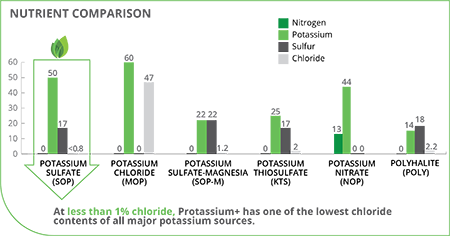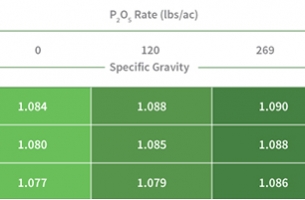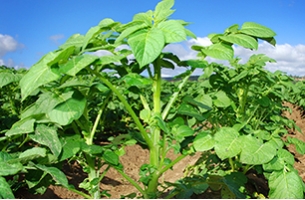Study Emphasizes Importance of Potassium in Optimizing Potato Yields and Quality
A new Oregon State University study shows that proper fertilization with potassium results in higher yields and, depending upon the potassium source used, better quality potatoes.
The study compared various sources of potassium applied at different times of the year. The results reinforced the importance of soil testing, and how interpreting those results correctly can allow growers to create an effective soil fertilization program. The results also show that using a low-chloride source of potassium, such as Protassium+® premium sulfate of potash (SOP) from Compass Minerals®, produces better quality potatoes.
Critical importance of K.
“Soil potassium rates are getting dangerously low, for several reasons,” says Dr. Don Horneck, the Oregon State University researcher behind the study.
“...Potassium is essential to growing good quality potatoes, so we must have adequate levels to optimize yields and quality.”
— Dr. Don Horneck
The study compared sulfate of potash (K2SO4) to potassium chloride (KCl) at four different rates and at two different application times (planting and layby). The results showed consistently better yields (as much as 10T/A more yield) when potatoes had adequate supplies of potassium. The study also showed that using SOP instead of KCl produced potatoes with a higher specific gravity, meaning more starch and less water in the harvested crop. Higher specific gravity can significantly lessen storage losses due to shrink.
“Potatoes need a lot of potassium. In some fields, the crop can remove as much as 800 lb./Acre of potassium a year,” explains Horneck. “The removal of potassium from the soil is greatest during bulking. We’ve seen rates up to 18 lb./Acre/day of potassium uptake. We have to replace that for the next crop.”
Horneck says soil test results can help growers determine the best timing for their potassium application.
“If soil tests show that there are low levels of potassium in the soil, their application timing options diminish,” says Horneck. ”If soil tests show very low levels of potassium in the soil, you can’t apply your potassium in the fall. For those soils very low in potassium, it’s best to do the application at layby.”
The Right K source for your soils.
Horneck also emphasizes the importance of knowing the difference between the various sources of potassium. Potassium chloride (or muriate of potash) can add unwanted salts into the soil and potentially damage the crop.
“The important difference between sulfate of potash and muriate of potash is the chloride content in muriate of potash versus the beneficial sulfate content in sulfate of potash,” explains Horneck. “Chloride can have negative effects on the potato itself, such as in specific gravity which is starch density.

Research has shown that Protassium+ sulfate of potash (0-0-50-17S) increases specific gravity in potatoes because it contains less than 1% chloride. Protassium+ fertilizer also has the lowest salt index per unit of K2O among all major sources of potassium. Protassium+ SOP has 17% sulfur is in the sulfate form and is immediately available for uptake and use by plants versus other sources like elemental sulfur. Addtionally, Protassium+ SOP is the richest source of low-chloride potassium, providing equivalent potassium content of 50% K2O, commonly referred to as potash.




